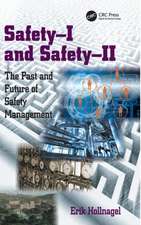Resilient Health Care, Volume 3: Reconciling Work-as-Imagined and Work-as-Done
Editat de Jeffrey Braithwaite, Robert L. Wears, Erik Hollnagelen Limba Engleză Hardback – 22 aug 2016
| Toate formatele și edițiile | Preț | Express |
|---|---|---|
| Paperback (1) | 431.35 lei 6-8 săpt. | |
| CRC Press – 12 dec 2019 | 431.35 lei 6-8 săpt. | |
| Hardback (1) | 783.25 lei 6-8 săpt. | |
| CRC Press – 22 aug 2016 | 783.25 lei 6-8 săpt. |
Preț: 783.25 lei
Preț vechi: 955.17 lei
-18% Nou
Puncte Express: 1175
Preț estimativ în valută:
149.92€ • 162.90$ • 126.02£
149.92€ • 162.90$ • 126.02£
Carte tipărită la comandă
Livrare economică 21 aprilie-05 mai
Preluare comenzi: 021 569.72.76
Specificații
ISBN-13: 9781498780568
ISBN-10: 1498780563
Pagini: 236
Ilustrații: 11
Dimensiuni: 156 x 234 x 19 mm
Greutate: 0.48 kg
Ediția:1
Editura: CRC Press
Colecția CRC Press
ISBN-10: 1498780563
Pagini: 236
Ilustrații: 11
Dimensiuni: 156 x 234 x 19 mm
Greutate: 0.48 kg
Ediția:1
Editura: CRC Press
Colecția CRC Press
Public țintă
Professional Practice & DevelopmentCuprins
Preface; Editors; Contributors; Prologue: Why Do Our Expectations of How Work Should Be Done; Never Correspond Exactly to How Work Is Done? Towards a Resilient and Lean Health Care; The Jack Spratt Problem: The Potential Downside of Lean Application in Health Care – A Threat to Safety II; Recovery to Resilience: A Patient Perspective; Is System Resilience Maintained at the Expense of Individual Resilience? Challenges in Implementing Resilient Health Care; Exploring Ways to Capture and Facilitate Work-as-Done That Interact with Health Information Technology; Resilience Work-as-Done in Everyday Clinical Work; Understanding Resilient Clinical Practices in Emergency Department Ecosystems; Reporting and Learning: From Extraordinary to Ordinary; Reflections on Resilience: Repertoires and System Features; Power and Resilience in Practice: Fitting a ‘Square Peg in a Round Hole’ in Everyday Clinical Work; Modelling Resilience and Researching the Gap between Work-as-Imagined and Work-as-Done; Simulation: Closing the Gap between Work-as-Imagined and Work-as-Done; Realigning Work-as-Imagined and Work-as-Done: Can Training Help? Resilient Procedures: Oxymoron or Innovation? Conclusion: Pathways Towards Reconciling WAI and WAD; References; Index
Notă biografică
Jeffrey Braithwaite, BA, MIR (Hons), MBA, DipLR, PhD, FAIM, FCHSM,
Recenzii
"This book pushes the boundaries of patient safety science and is essential reading for all those interested in creating better, safer, health systems."
—Russell Mannion, University of Birmingham, United Kingdom
"I really like the highly international nature of the chapter authorship and also the way in which chapters blended together both a resilience engineering prism and an organizational behavior perspective, which is unusual and encouraging."
— Ewan Ferlie, King’s College London, United Kingdom
"The book justifies an important shift in perspective: from the ‘find-and-fix’ approach that focuses on where the system is not working to a more positive focus on how things do work and how we can learn from models of good practice."
— Trisha Greenhalgh, University of Oxford, United Kingdom
"This book builds a much needed bridge over the gap between our plans for care and the reality of practice. It makes a valuable contribution to the RHC series. As the final installment of the trilogy of books on this topic it offers a range of perspectives and challenges to thinking on this topic that will be of interest to students and practitioners interested in health care improvement and re-design."
— Catherine Pope, University of Southampton, United Kingdom
"The change of perspective from Safety I to Safety II is a major breakthrough in thinking about patient safety, emphasizing the complex and dynamic interactions that characterize much healthcare practices. Putting the relation between ‘work-as-imagined’ and ‘work-as-done’ center stage, this book adds to those critical insights by offering tools (and re-analyzing existing ones) that help both scholars and practitioners in researching and designing safer healthcare systems."
— Roland Bal, Erasmus University Rotterdam, Netherlands
—Russell Mannion, University of Birmingham, United Kingdom
"I really like the highly international nature of the chapter authorship and also the way in which chapters blended together both a resilience engineering prism and an organizational behavior perspective, which is unusual and encouraging."
— Ewan Ferlie, King’s College London, United Kingdom
"The book justifies an important shift in perspective: from the ‘find-and-fix’ approach that focuses on where the system is not working to a more positive focus on how things do work and how we can learn from models of good practice."
— Trisha Greenhalgh, University of Oxford, United Kingdom
"This book builds a much needed bridge over the gap between our plans for care and the reality of practice. It makes a valuable contribution to the RHC series. As the final installment of the trilogy of books on this topic it offers a range of perspectives and challenges to thinking on this topic that will be of interest to students and practitioners interested in health care improvement and re-design."
— Catherine Pope, University of Southampton, United Kingdom
"The change of perspective from Safety I to Safety II is a major breakthrough in thinking about patient safety, emphasizing the complex and dynamic interactions that characterize much healthcare practices. Putting the relation between ‘work-as-imagined’ and ‘work-as-done’ center stage, this book adds to those critical insights by offering tools (and re-analyzing existing ones) that help both scholars and practitioners in researching and designing safer healthcare systems."
— Roland Bal, Erasmus University Rotterdam, Netherlands
Descriere
This book is the 3rd volume in the Resilient Health Care series. Resilient health care is a product of both the policy and managerial efforts to organize, fund and improve services, and the clinical care which is delivered directly to patients.





























